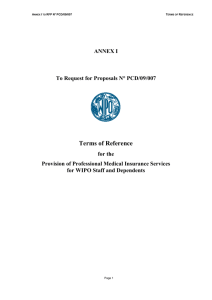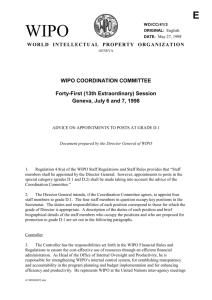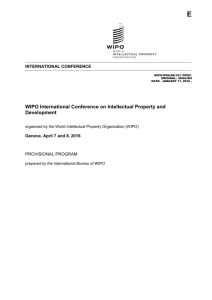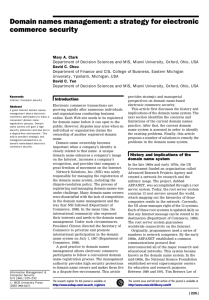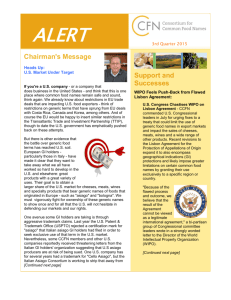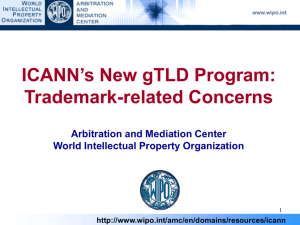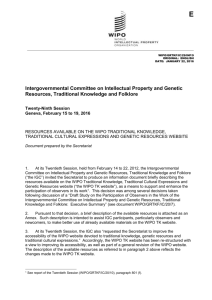IV. The Exercise and Management of IP Rights in Electronic
advertisement
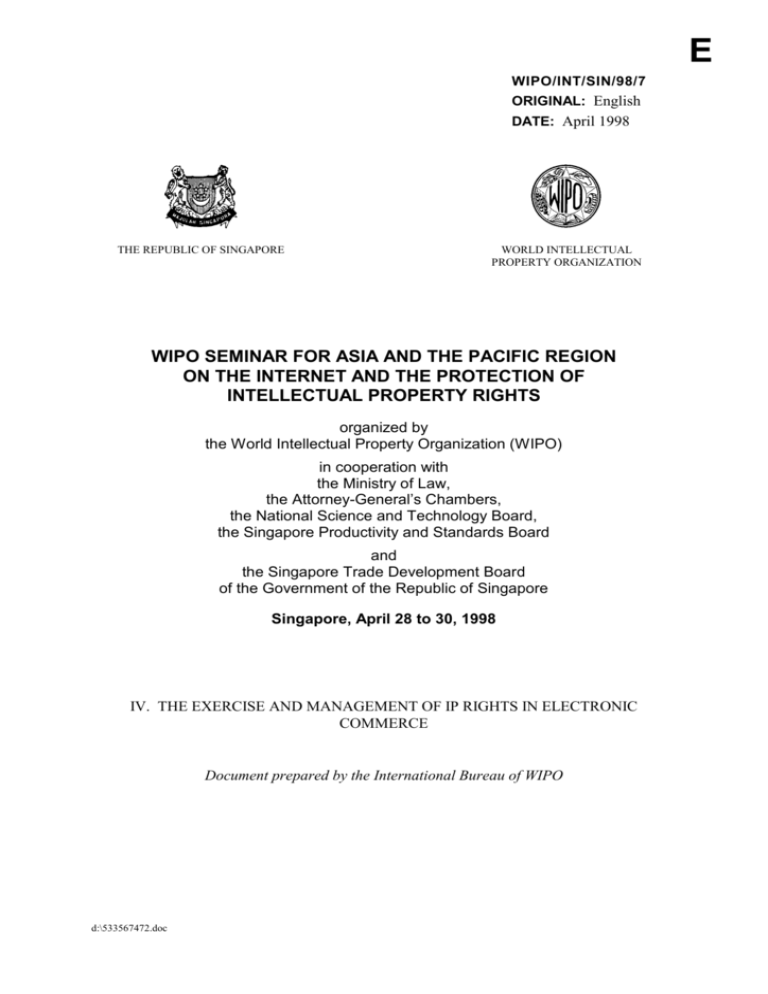
E WIPO/INT/SIN/98/7 ORIGINAL: English DATE: April 1998 THE REPUBLIC OF SINGAPORE WORLD INTELLECTUAL PROPERTY ORGANIZATION WIPO SEMINAR FOR ASIA AND THE PACIFIC REGION ON THE INTERNET AND THE PROTECTION OF INTELLECTUAL PROPERTY RIGHTS organized by the World Intellectual Property Organization (WIPO) in cooperation with the Ministry of Law, the Attorney-General’s Chambers, the National Science and Technology Board, the Singapore Productivity and Standards Board and the Singapore Trade Development Board of the Government of the Republic of Singapore Singapore, April 28 to 30, 1998 IV. THE EXERCISE AND MANAGEMENT OF IP RIGHTS IN ELECTRONIC COMMERCE Document prepared by the International Bureau of WIPO d:\533567472.doc WIPO/INT/SIN/98/7 page 2 1. THE INTERNET AS A GLOBAL MARKET - The Internet is a network of networks, basically a series of computers around the globe that are connected to and are able to communicate with each other. - The Internet started in the United States as the Advanced Research Projects Agency Network (ARPAnet), an experimental computer network sponsored by the US military. - The goal was to construct a robust network connecting strategic sites that was able to withstand a nuclear attack. - Next to its military purpose and before the advent of electronic commerce, the Internet functioned primarily as a network for research and education. - The Internet is now transforming into a virtual and global market (note that, currently, the primary use of the Internet is still e-mail). - Electronic commerce may be conducted in various ways over the Internet, each reflecting a different stage in the maturity of the Internet as a commercial medium: - 2. Model 1: Establishment of presence on the Internet by way of a passive website on which content is published for marketing purposes. Model 2: Allowing on-line orders for products (possibly including online credit card payment) through an interactive website but the products are delivered physically (e.g. on-line book stores). Model 3: All aspects of transaction are handled on-line including delivery of the product (e.g. on-line distribution of software) Currently, most business activity seems to be centered around models 1 and 2, but it is model 3 that reflects the greatest promise of the Internet as a commercial medium. THE INTERNET AND THE PROTECTION OF IP RIGHTS IN GENERAL - As the Internet develops into a marketplace, the legal dimensions of doing business on the Internet have come to the fore, e.g.: advertising, on-line contracts, on-line payments, data security (including authenticity and confidentiality), taxation, exercise and management of IP rights, etc. - The exercise and management of IP rights is of central importance to any discussion regarding the legal aspects of doing business on the Internet. WIPO/INT/SIN/98/7 page 3 3. - This is explained by the close association between IP rights and the information technology on which the Internet is based. Furthermore, the Internet is expected to develop into an important vehicle for the commercial distribution of content, the ownership of which is protected by IP rights. - Because of its original purpose, the Internet developed into an open and distributed network, promoting the free flow of ideas and the purposeful creation of a pool of shared knowledge and information. - The Internet has been conceived to stimulate precisely the opposite of what IP law is intended to achieve, namely the protection of the interests of right holders in the dissemination of their assets or works by preventing their free flow. LEGAL CHALLENGES PRESENTED BY THE INTERNET - - The open and distributed character of the Internet presents a number of important challenges: 1. As material can be disseminated over the entire globe through the Internet in a matter of seconds, national boundaries have becomes meaningless. 2. The traditional approach of regulating activity on the basis of differing national laws does not fit well with the global character of the Internet. 3. Solutions based on choice-of-law approaches are difficult to implement because it is often not clear where a particular activity occurred (e.g. in which country was a copy of a book illegally uploaded for dissemination purposes or where was it downloaded...). 4. Material existing in traditional format can easily be converted into digitized form. 5. It is easy and inexpensive to make perfect digitized copies of material and distribute them on a wide scale. 6. Often it is not possible to identify and locate the person who is at the source of the activity (e.g. anonymous re-mailers). In view of the above, it appears that: 1. Approaching the problem from the legal perspective alone will not be sufficient; it is likely that solutions at least in part will need to be technical (“automated rights management”); 2. The problem is best handled at the international level (by private and/or public sector). WIPO/INT/SIN/98/7 page 4 4. DISTRIBUTION OF PRODUCTS OVER THE INTERNET - To illustrate IP and other rights affected by electronic commerce, imagine a company that wishes to engage in the large-scale on-line distribution of multimedia products through the Internet. - Multimedia are products that: 1. Consist of a combination of software and multiple forms of content such as text, sounds and images; 2. Are in digital form; 3. Are stored and delivered via computer technology; and 4. Are used in an interactive and non-linear fashion. - Because multimedia products bundle various forms of content protected by IP rights and exist in digital form, they illustrate well which types of rights need to be considered and possibly licensed when engaging in electronic commerce. - While the current state of technology may not allow this type of activity to flourish for the time being (limitations on transmission of video and sound), it is expected that this will change in the next few years. - To achieve its goal of distributing multimedia products through the Internet, the company will need to: - 1. Create multimedia products; 2. Set up a website offering the product; 3. Distribute the product to its clients through the Internet; 4. Together with any other right holders, protect its investment in the product by ensuring that it is not illegally copied and distributed. Each step in this process requires the consideration and management of various types of IP rights. WIPO/INT/SIN/98/7 page 5 5. CREATING THE MULTIMEDIA PRODUCT - Assuming the company does not create its own content, but uses pre-existing content created by others, the company may need to obtain several licenses from the relevant rightholders. - Depending on the type of content, the applicable law may vary and different licenses may need to be obtained: - 6. 1. Text: copyright and trademark. 2. Databases: special consideration of the extent to which IP law protects compilations and licenses are required. See recent developments in the United States, Europe and WIPO. 3. Characters: copyright and trademark. 4. Musical works: copyright. 5. Sound recordings: copyright, trademarks, rights of publicity. 6. Pictures and still images: copyright, trademark, and right of publicity. 7. Audiovisual works: copyright and rights of publicity. 8. Software: copyright and patent. Once the company has created its multimedia products, it is ready to offer its products on its website. CREATING THE WEBSITE - One of the first steps in establishing a website is to register a domain name, i.e. a website address. This domain name may be registered at the national level (e.g. “nccnet.ch”) or at the international level (e.g. “microsoft.com”). - For marketing purposes, it is useful to incorporate a trademark into a domain name. This may raise a number of trademark management problems. - Because of the first come, first served principle applicable to domain name registrations, a company may be prevented from incorporating its trademark into its domain name, if another person or entity has registered this name earlier. This may happen even if this other person or entity has no rights in the name, as domain name registrars generally do not verify whether the registrant holds any rights in the name it intends to register. WIPO/INT/SIN/98/7 page 6 7. - Furthermore, other companies operating in different countries may own the trademark in question. To the extent the company wishes to distribute its products in those other countries, such activity may constitute infringement, particularly if the other companies are in the same line of business. - Apart from obtaining a domain name, the company also must create its webpages. - Webpage developers often get their inspiration by surfing on the Net and looking at existing websites. Often these creations will be protected by copyright. See recent developments at the United States Register of Copyrights. - Trademarks may be incorporated not only in the domain name but also in the webpages themselves. Similar trademark management issues may therefore arise with regard to the webpages. DISTRIBUTING THE PRODUCTS OVER THE INTERNET - Several of the methods and products that are used to distribute content over the Internet may be subject to IP rights. 1. Electronic Sales Systems. Programs are now available for constructing fully integrated on-line stores. These systems may be patented. See recent decisions by USPTO and possible effect on online payment systems. 2. Communication protocols. These are prearranged sets of formats and procedures that computers use to exchange data. While many protocols are in the public domain, some protocols may be patented. 3. Data compression tools. These tools are able to reduce the size of data files. They are particularly important for the online transmission of audio and video files. Data compression techniques are patentable in certain countries including the United States. There have been some difficulties in the United States with patent rights in data compression tools such as the GIF (Graphics Interface Format). GIF was widely believed by developers to be in the public domain, but in fact was patented by Unisys. 4. Data encryption techniques. Encryption allows data to be scrambled so that it can be read only by the person holding a key that is able to decode the data. Encryption techniques will be critically important for the further development of the Internet as a commercial medium as they enable the secure exchange of data over public networks. In this respect, they are likely to become an important means of ensuring that copyrighted material transmitted through the Internet cannot be intercepted. Encryption techniques may be patentable. RSA (Rivest, WIPO/INT/SIN/98/7 page 7 Shamir and Adleman), one of the leading public key encryption systems, is patented in the United States and is widely licensed to developers including Microsoft, Lotus and Novell. - 8. 9. Potential patent infringement in connection with the above tools is more often an issue for the developer of the tools than the end-user. Usually, it will be the developer who is primarily responsible for obtaining the required licenses. However, it is nonetheless worthwhile for end-users, particularly those with deep pockets, to be cautious and to check whether they are covered by their developers through appropriate warranties stating that their products do not infringe upon the rights of third parties. PROTECTING THE RIGHTS THAT HAVE BEEN DISTRIBUTED - Managing the IP rights of products distributed over the Internet is one of the most vexing problems. - This subject has been debated primarily in the area of copyright law. - A particular issue is the liability of service providers. See recent developments in the United States. - Another major issue is whether the rightholders will be able to manage individually their IP rights on the Internet, or whether such rights are best managed collectively through collective administration agencies. - As explained above, one of the key issues is the ease with which digitized products can be copied and distributed over the Internet. Furthermore, products originally not in digitized form easily can be converted into digital objects for distribution purposes without the consent of the relevant rightholders. - It is likely that a legal approach to the problem will not be sufficient. Technical measures allowing to track the objects in question, limiting their interception by third parties (comparable to satellite television scrambling techniques), and restricting the extent to which they can be copied will need to supplement any legal solutions that may be devised. SUMMARY - The Internet, a global network of networks was used primarily for research and educational purposes and is now in the process of changing into a virtual and global market. - The Internet is an open and distributed network that is not easily converted into a robust and secure legal environment supporting worldwide electronic commerce. WIPO/INT/SIN/98/7 page 8 - Most commercial activity on the Internet to varying degrees implicates intellectual property rights including trademarks, copyrights and patents. - The proper management of intellectual property rights on the Internet likely will require a minimum of international coordination and the appropriate blend of legal and technical solutions. [End of document]
![Invitation [word format]](http://s3.studylib.net/store/data/007096478_1-54334bf5ab877bf1ebd233e686a3f8bb-300x300.png)
